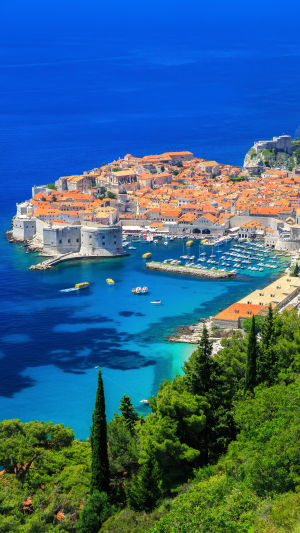Dubrovnik is a stunning city located on a limestone peninsula on the southern tip of Croatia's Dalmatian coast. Covering an area of 364 square kilometers, it boasts a beautiful and temperate climate, and it looks like a medieval city from ancient times.
The city is divided into two parts: the Old Town and the New Town. The Old Town is a historic castle built from granite in the 14th-16th centuries on a large rock jutting out into the sea. It is surrounded by a moat on the northern side and is bordered by the sea on the eastern, southern, and western sides.
The walls are adorned with corner towers and gun towers, and it has well-preserved monasteries, pharmacies, palaces, and bell towers from the 14th-16th centuries. Rows of red-roofed buildings in Roman, Gothic, Renaissance, and Baroque styles adorn the hill, and even the streets and street lights are ancient.
On the other hand, the New Town has modern theaters, luxurious hotels, residential houses, and other tourist facilities. It's built on the gentle slopes of the central seafront.
Dubrovnik's islands are dotted with mountains and seas, lush forests, clear water, sunshine, and stunning landscapes. The average annual temperature is 17℃, and the average winter and summer temperatures are 10℃ and 26℃, respectively.
The city receives an average annual precipitation of about 1,021 mm and has about 250 days of sunshine annually. Dubrovnik is home to the City Museum and other notable landmarks. It's the largest vacation resort in Croatia and a must-visit place for tourists from all over the world.
The Walls of Dubrovnik are defensive stone walls that surround the Old Town. The walls were first built in the 7th century and were similar to "wooden fences." Most of the present walls were built in the 12th-17th centuries, with the highest 25 meters of the wall bordering the sea.
The wall is 4-6 meters thick on the land side and 1.5-3 meters thick on the seaside. The wall's uninterrupted length is 1,940 meters and has five gates, two corner fortifications, three round watchtowers, and 14 square watchtowers that defend against enemy fire from different directions on land and sea.
A moat lies outside the land wall, and a drawbridge is located at the early entrance. It's the largest, most complete, and most complex wall system in Europe.
The walls protected the peace and prosperity of Ragusa for five centuries, making them one of the greatest defensive systems of the Middle Ages. In 1979, the Old Town of Dubrovnik was inscribed on the World Heritage List, along with a large part of the walls.
The Fountain of Onovlio, situated at the beginning of Praca Street, was built in 1438 by Onoferio, an architect from Naples, Italy.
The fountain was the city's drinking water supply system at that time, and it was located at the point of entry to the city. The water comes from the town of Rijeka, which is 12 kilometers away from Dubrovnik, and it's brought here through a covered ditch.
For a long time, it has been customary for people entering the city to wash their hands at the fountain to avoid bringing "bad luck" into the city. Nowadays, the place is always full of visitors who want to rest their feet.





